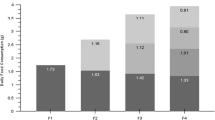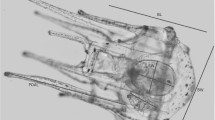Abstract
To determine the effects food ration and feeding regime on growth and reproduction of Strongylocentrotus droebachiensis (Müller), sea urchins in laboratory aquaria were fed kelp (Laminaria longicruris) supplied at either a high (H, ad libidum daily) or a low (L, ad libidum 1 d wk−1) ration in two successive 12-wk intervals during the reproductive period. After 24 wk, urchins fed the high ration continuously (HH) or for the last 12 wk only (LH) had a significantly greater mean gonad index [(gonad weight/total body weight) × 100] and body weight than urchins fed the low ration continuously (LL) or for the last 12 wk only (HL). Urchins in the HL treatment had a significantly greater gonad index than those in the LL treatment; there was no significant difference in gonad index between the LH and HH treatments. Females had a greater gonad index than males in the low ration (LL and HL) treatments at the end of the experiment; there was no significant difference between sexes in the high ration (LH, HH) treatments. Gametogenesis proceeded to maturation in all treatments and some individuals spawned at the end of the experiment. Females in the high ration (HH and LH) treatments had a greater proportion of nutritive phagocytes in their ovaries than females in the low ration treatments, but there was no effect of feeding treatment on oocyte or ovum size. Feeding treatment had no effect on the relative abundance of nutritive phagocytes in the testes, although the proportion of spermatocytes was higher (and that of spermatozoa lower) in the high ration than in the low ration treatments. Urchins in the high ration treatments had a lower mean jaw height index [(jaw height/test diameter) × 100] and greater mean test diameter than those in the low ration treatments at the end of the experiment, although these differences were not statistically significant. Feeding rate on kelp at the end of the experiment was significantly greater for urchins in the low ration than in the high ration treatments. Our experimental results show that even relatively low rations of kelp support somatic and gonadal growth in S. droebachiensis. Increasing the supply of kelp, particularly during the period of active gametogenesis, results in maximal rates of growth and reproduction. These results suggest that populations of S. droebachiensis in barrens may derive a substantial proportion of their nutrition from drift kelp, which may contribute to their persistence in these habitats. They also explain the large body size, high reproductive effort and fecundity of urchins grazing on kelp beds. These findings have important implications for understanding the dynamics of natural populations of S. droebachiensis and for development of effective aquacultural practices.
Similar content being viewed by others
Author information
Authors and Affiliations
Additional information
Received: 17 February 1997 / Accepted: 5 March 1997
Rights and permissions
About this article
Cite this article
Minor, M., Scheibling, R. Effects of food ration and feeding regime on growth and reproduction of the sea urchin Strongylocentrotus droebachiensis . Marine Biology 129, 159–167 (1997). https://doi.org/10.1007/s002270050156
Issue Date:
DOI: https://doi.org/10.1007/s002270050156




